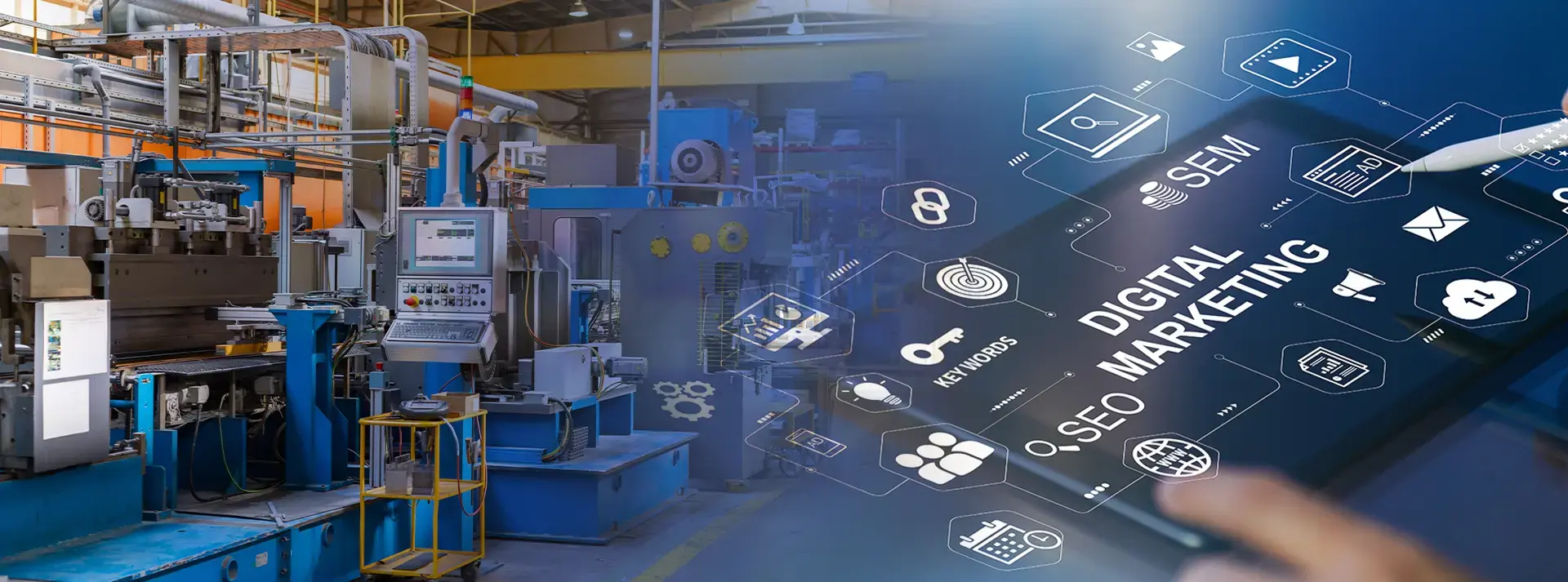When it comes to manufacturing and marketing, one thing’s for sure – change is constant. Innovations, fresh trends and the latest must-do tactics are always popping up. One day, it feels like you’re running on a hamster wheel to keep up; the next, you’re on top of the world, like you’ve just conquered Mount Everest.
It’s thrilling, it’s ever-evolving, and it’s that relentless drive toward innovation and progress that draws us to both worlds — marketing and manufacturing. So, let’s keep the excitement going as we dive into the top 7 trends that will shape industrial marketing in 2025:
- Generative AI pushes efficiency to new heights.
- No-click SEO is no joke.
- Expertise takes center stage with content marketing.
- Digital ads go niche for maximum impact.
- Video remains the reigning heavyweight.
- Demand gen and lead gen are the ultimate growth duo.
- The right tool stack = success.
Read on to learn more about each of these trends.
1. Generative AI pushes efficiency to new heights.
No platform or technology is shaking up the marketing space quite like generative AI. Marketers use AI tools to create content, brainstorm campaigns and streamline tasks. According to a recent study, 37% of marketers are now using AI tools in their daily tasks.
Here at Marketing Essentials, we use AI to brainstorm ideas, polish writing, conduct keyword research, support analysis and forecasting, solve coding issues and automate marketing functions. It makes us more efficient and precise, however, it doesn’t replace the creativity and strategy that we, as human marketers, bring to the table.
This human-and-machine approach aligns right with Industry 5.0, which is reshaping not only manufacturing but also marketing.
2. No-click SEO is no joke.
Also called zero-click SEO, this refers to the growing trend of fewer people clicking through to websites from Google. According to Sparktoro, less than 60% of searches for tracked keywords result in a click, with users often finding their answers directly on Google.
So, how can you compete in a zero-click world? The answer lies in high-quality, strategic content. Take a hard look at your overall content and SEO strategy. Are you providing high-quality content that answers your buyers’ questions? Is your content both comprehensive and easily digestible? Is your content expert and authentic?
The goal? Make your brand the go-to source for both buyers and search engines seeking a brand they trust for expert insights and answers.
3. Expertise takes center stage in content marketing.
In a world of content overload, content that educates and empowers buyers will be the cornerstone of successful marketing strategies. People don't have time for content that doesn’t add value.
For manufacturers, this means creating technical blog posts, detailed case studies, informative white papers or “how-it’s-made” videos demonstrating expertise and transparency. High-quality content like this fosters relationships, making your brand top of mind when buyers are ready to make a purchase.
4. Digital ads go niche for maximum impact.
The era of broad campaigns is over. Target. Target. Target. Given that manufacturing often involves specialized products for select industries, niche targeting isn’t just beneficial — it’s essential.
While targeted advertising isn’t new, it’s becoming even more critical as we move into 2025. By leveraging Google Ads, Microsoft Ads and other platforms, manufacturers can tailor ads to niche markets, delivering messages to specific industries, roles or even companies. This approach ensures your marketing dollars are spent efficiently and for maximum ROI, reaching decision-makers who are genuinely interested in your offerings.
5. Video remains the reigning heavyweight.
With video consumption at an all-time high, this medium remains a must-have for engaging audiences, showcasing products and driving conversions. HubSpot describes video as “one of, if not the, most important marketing trends today and likely for the next 5-10 years.”
If you’re not using video yet, it’s time to catch up. Behind-the-scenes videos that show off your team, manufacturing processes and products give potential customers a real sense of what partnering with you looks like, answering their questions and building trust along the way.
6. Demand gen and lead gen are the ultimate growth duo.
In 2025, the key to growth is aligning demand generation and lead generation rather than running them in silos. No more asking which strategy you should be doing. The answer is: Both.
“If you’re only doing lead gen without demand gen at the top of the funnel, lead gen won’t be as effective,” explains Tyler Louth, CEO of Marketing Essentials. “And if you’re only focused on demand gen, you’ll struggle with quality leads.”
Demand generation builds early awareness, creating a pool of informed prospects. Lead generation then captures these prospects, nurturing them with targeted content. Together, the two strategies form a seamless pipeline, drawing in and converting leads at the right time for sustainable growth.
7. The right tool stack = success.
Brutal truth: You’re not winning if your sales team still tracks leads on Excel spreadsheets!
In 2025, investing in sales technology is a must — not just for better prospecting and selling, but for attracting and keeping top talent. Today’s workforce expects tech at their fingertips, and relying on notebooks and spreadsheets risks losing both sales opportunities and skilled employees.
Now’s the time to assess your CRM and Marketing Automation Platform (MAP) — or, if you don’t have these yet, to explore your options. A strong CRM and MAP bring powerful features that solve multiple challenges, making your sales and marketing teams more efficient than ever. Just like the right machines on the floor, success starts with the right technology in place.
Ready to Evaluate Your Marketing Strategy in 2025?
Start by requesting your complimentary 30-minute consultation with our industrial marketing experts.



